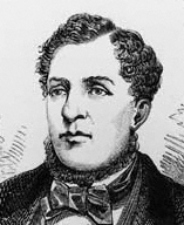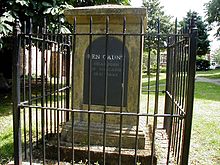Ben Caunt
Ben Caunt | |
|---|---|
 Ben Caunt, by unknown engraver | |
| Born | 22 March 1815 Hucknall Torkard, Nottinghamshire, England |
| Died | 10 September 1861 (aged 46) |
| Nationality | English |
| Other names | Torkard Giant, Big Ben |
| Statistics | |
| Weight(s) | 18 st (250 lb; 110 kg) |
| Height | 6 ft 2 in (1.88 m) |
Ben Caunt (22 March 1815 – 10 September 1861) was a 19th-century English bare-knuckle boxer who became the heavyweight boxing champion known as the "Torkard Giant" and "Big Ben".
Early life
[edit]Caunt was born on 22 March 1815 in Hucknall Torkard, in Nottinghamshire, England.[1] Caunt stood 6 feet 2 inches (1.88 m) tall and weighed 18 stone.[2][3] He was said to be strong, durable, and willing yet also slow and clumsy. His early boxing career is not well known, but he did defeat several minor local opponents at the age of 18.
Boxing career
[edit]In 1834 he beat George Graham (of Lincolnshire). On 21 July 1835, Caunt boxed William "Bendigo" Thompson and was disqualified for an alleged foul striking Thompson while he was sitting in his corner.[4]
On 17 August 1837, Caunt fought and beat William Butler at Stoneyford in Derbyshire, and on 4 November Bill Boniford at Sunrise Hill.
On 3 April 1838, Caunt again fought William Thompson on Skipworth Common, and after 76 rounds Thompson was disqualified for going down without being struck; Caunt claimed the Heavyweight Championship of England but this was not generally accepted.[3]
On 24 June of the same year, Caunt was scheduled to again fight William Thompson but the bout was cancelled.
On 26 October 1840, Caunt defeated Bill Brassey at Six Mile Bottom in 101 rounds.
On 2 February 1841, Caunt fought Nick Ward on Crookham Common for the Heavyweight Championship of England where the crowd forced the referee to disqualify Caunt for an alleged blow striking Ward while he was down.
Caunt avenged this defeat on 11 May of the same year, defeating Ward in 35 rounds at Long Marston to become the Heavyweight Champion of England. On 10 September 1841 Caunt sailed to America to challenge Tom Hyer to a world championship bout, but Hyer never replied. Caunt returned to England on 10 March 1842 with the "American Giant" Charles Freeman.[1]

In 1845 he was challenged for the English heavyweight title by William Thompson. On 9 September Caunt lost at Stony Stratford, with a disputable decision after 93 rounds where it was alleged that Caunt went down without a blow striking him. Caunt denied this accusation and announced his retirement, only to return for a final attempt at the heavyweight crown 12 years later.
Retirement and attempted comeback
[edit]Between 1845 and 1851, Caunt worked as farm labourer and then became the landlord of the Coach and Horses pub at St Martin's Lane, a business that made him very prosperous until the premises were destroyed in a fire that killed two of his children.
In his final fight on 21 September 1857, Caunt fought Nat Langham at Home Circuit, where after 60 rounds both men were too exhausted to continue and a draw was declared.
Death and legacy
[edit]Caunt died of pneumonia on 10 September 1861 at an address in St Martin's Lane in London. He is buried outside the north transept of the Parish Church of St Mary Magdalene in Hucknall close to the grave of his two children who died in the Coach and Horses fire.[3]
It is said that Big Ben, the hour bell of the clock-tower of the Palace of Westminster, is named after this English heavyweight champion. The origin of the name is contested with Westminster's Chief Lord of the Woods and Forests, Sir Benjamin Hall. A large and ponderous man known affectionately in the House as "Big Ben", he is said to have given an impressively long speech on the subject. When, at the end of this oratorical marathon, Sir Benjamin sank back into his seat, a wag in the chamber shouted out: "Why not call him Big Ben and have done with it?" The house erupted in laughter; Big Ben had been named. This, at least, is the most commonly accepted story. However, according to the booklet written for the old Ministry of Works by Alan Phillips (1959):
Like other nice stories, this has no documentary support; Hansard failed to record the interjection. The Times had been alluding to 'Big Ben of Westminster' since 1856. Probably, the derivation must be sought more remotely. The current champion of the prize ring was Benjamin Caunt, who had fought terrific battles with Bendigo, and who in 1857 lasted sixty rounds of a drawn contest in his final appearance at the age of 42. As Caunt at one period scaled 17 stone (238 lbs, or 108 kilogrammes), his nickname was Big Ben, and that was readily bestowed by the populace on any object the heaviest of its class. So the anonymous MP may have snatched at what was already a catchphrase.[5]
— Alan Phillips
References
[edit]- ^ a b Boase, George Clement (1887). Dictionary of National Biography, 1885-1900, Volume 09. pp. 331, 332.
- ^ Hess, John (27 July 2012). "Could Big Ben lose out in Diamond Jubilee name change?". BBC News. BBC. Retrieved 1 February 2013.
- ^ a b c "Ashfield District Council: 'Big' Ben Caunt". Archived from the original on 13 June 2011. Retrieved 17 July 2017.
- ^ Walker, James (23 December 2014). "LeftLion - Ben Caunt". LeftLion. Retrieved 25 December 2018.
- ^ Phillips, Alan (1959). "The Story of Big Ben". Whitechapel Bell Foundry. Ministry of Works: Her Majesty's Stationery Office. Retrieved 25 December 2018.
